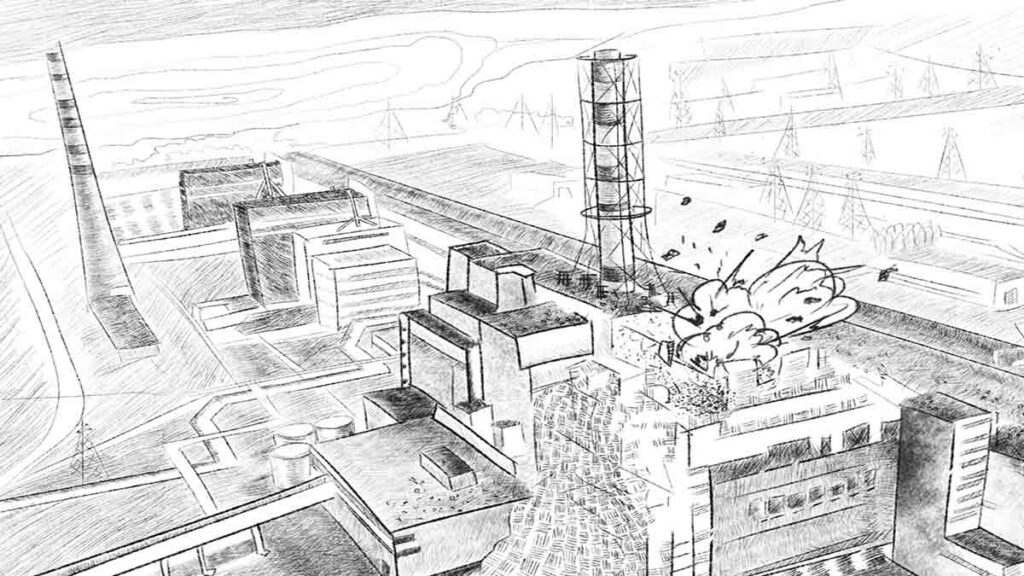
The structure, wrapped in a dull gray metal dome, is still the most dangerous building on the planet. Approaching its walls, a special radiation detector pierces the silence with a furious, piercing sound – this is a danger signal.
Death still lives in this terrible building – it cannot be seen or heard, it cannot be sniffed, or felt, but it is everywhere in it. Climbing the roof, people in special hermetic clothing examine this flat field, cleaned at the cost of the lives of hundreds of liquidators of the Chernobyl accident…
600 thousand people – exactly so many rescuers were involved in the liquidation of the Chernobyl accident. But about four thousand of them had a special mission. They would be called “biorobots” by those who sent young volunteers to complete a seemingly impossible task.
The graphite rods of the reactor were scattered over a great distance because of the shock wave from the explosion of the 4th power unit. They posed a mortal threat. In the process of developing measures to eliminate the consequences of the Chernobyl accident, the entire area of the nuclear power plant was divided into several sections, numbered not with numbers, but with the letters N.L.K.M., which were later given female names – Katya, Lyuda, Nina, Masha.
The last section, “Masha”, got the most. It was located at the very throat of the reactor, and met each with a terrifying 8,000 x-rays. All life around turned into dust, after literally a few minutes.
Masha Zone and Bioconveyor
To clear the remains of the roof of radioactive graphite and dump its scattered pieces deep into the reactor was an extremely complex and archival necessary, almost impossible task. The entire subsequent set of measures to deal with the consequences of the accident depended precisely on whether the liquidators could cope with it.
It was decided to clean the “M – Masha” zone with the help of robots. It was believed that Soviet engineering in the field of robotics is the most advanced in the world and will be able to independently manufacture the necessary remote liquidator. But it turned out that the parade of techno-robots provided by the Soviet experimental institutes was ridiculous and useless. Individual specimens were mounted from a conventional tractor sheathed with lead sheets, while others generally resembled a “table on wheels”.
An alternative to Soviet experimental creativity had to become a German instance – JOKER, provided by West Germany as part of partnership and cooperation. A German robot managed to unload on the remains of the destroyed roof of the reactor with the help of helicopters,.
The work was started, it passed not more than a meter and, catching on a caterpillar for a large graphite block, it stopped. It was a huge effort to lift and rearrange it, but it still did not work – the electronics simply burned out.
The German had robot never dropped a single piece of graphite from the roof. As it turned out later, the reason was that when ordering ultramodern equipment, the Soviet government intentionally reduced the dose of radiation at which it was planned to use it.
Reduced, so as not to cause a negative reaction of the international community. Learn then about the real danger on a planetary scale – the wave of international indignation towards the Soviet government was no less catastrophic.
The equipment refused to work, so they found the only way out — to send living people to the “M – Masha” zone. The state, which for decades was considered a power with super space achievements, could not offer anything better than to shift the problem of clearing graphite fragments to the shoulders of 25-35 year old volunteers.
The young guys were dressed in a lead vest, rubberized apron, and sent for a minute and a half, one after another, by conveyor, right into the crater of the exploding reactor. There were no radios, the only source of communication was the ringing on a metal rail, indicating a signal of urgent return.
It was believed that the total amount of radiation received during this time was not much more than 25 rem, although in fact it was several times larger. And so, in the hope of surviving, biorobot-like volunteers counted out every second in their heads, climbing the metal ladder and clutching a shovel in their hands.
Then, 33 years ago, the volunteers clearly realized that the upcoming one and a half minutes of life would be decisive for them when setting off on the roof of a destroyed nuclear reactor. For someone heroic, but for someone, if something goes wrong – the last in life. Such a bioconveyor was effective and reliable. Volunteers carried out their mission with dignity.
Chernobyl today
And today this place remains extremely dangerous, you can be without risk to life there for no more than five minutes. Chernobyl will never become the past, it is our present and our future, to live with which we must be extremely careful and as professional as possible so that these catastrophic numbers have never happened again:
- as a result of the Chernobyl disaster, 1,961,904 people were injured;
- radiation of isotopes is 30-40 times greater than 300 dropped atomic bombs in the city of Hiroshima;
- 60 tons of radioactive substances took to the air, including isotopes of uranium, plutonium, iodine-131, cesium-134, cesium-137, strontium-90;
- 30 km is the radius of the exclusion zone;
- 600,000 liquidators were involved in the aftermath of the accident.
- according to the world health organization, 4000 thousand people have died of the Chernobyl disaster and may die in the future from its consequences
- 31 people died in the first days directly from the Chernobyl accident
- 200 thousand km is the area of radioactive contamination.